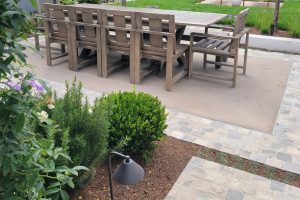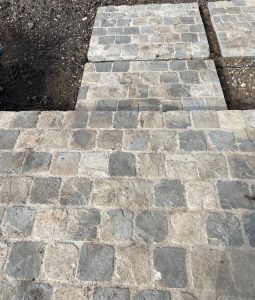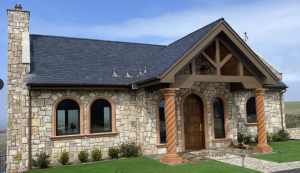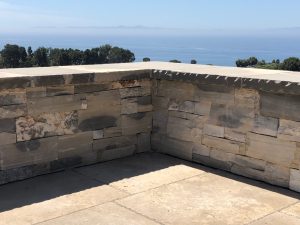Using flagstone in landscaping is an art that blends functionality with natural beauty. Flagstone’s rugged textures, earthy tones, and unique shapes allow for endless creative possibilities. Whether you’re designing walkways, patios, or garden walls, incorporating flagstone into your landscape design can elevate your outdoor space with a timeless and sophisticated look. This guide by Lompoc Stone provides design tips, expert tricks, and project ideas for creating stunning landscapes using flagstone.
Understanding Flagstone’s Role in Landscaping
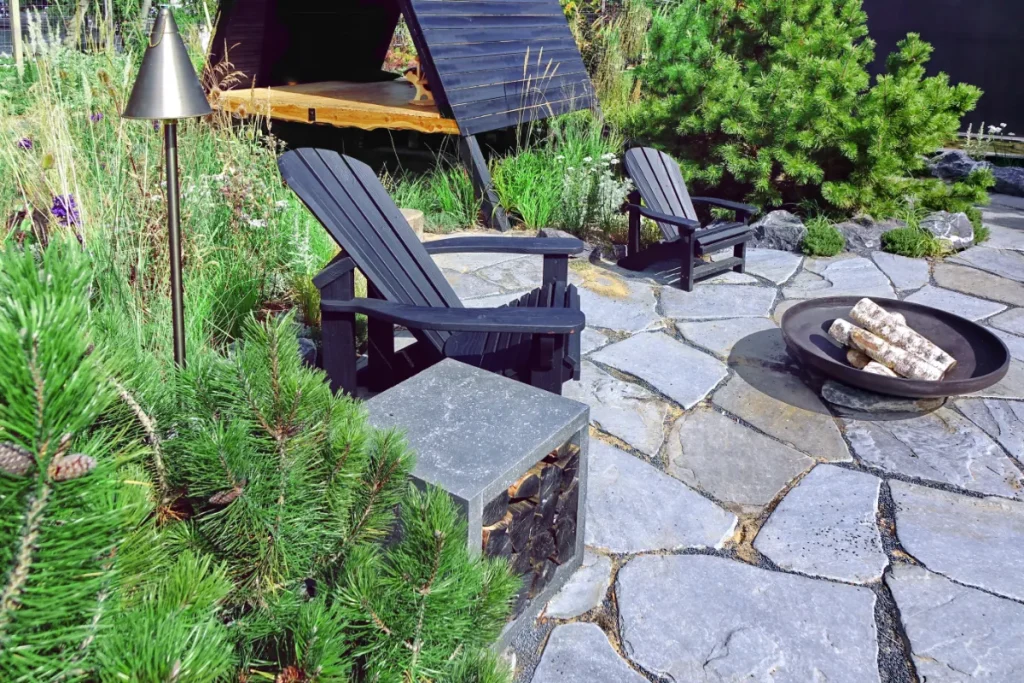
When it comes to transforming outdoor spaces, using flagstone in landscaping stands out as one of the most versatile and visually appealing options.
Its natural charm, combined with its ability to withstand the elements, makes it perfect for a variety of projects. Understanding the characteristics of flagstone can help you plan and execute a successful landscaping design.
What Is Flagstone?
Flagstone is a sedimentary rock typically cut into flat slabs for use in outdoor construction and landscaping. It is made of layers of stone that naturally break into smooth, flat sections. Common types include sandstone, limestone, and slate, each offering different textures and colors. Flagstone is available in a range of earth tones, including grays, browns, reds, and greens, allowing it to blend seamlessly into natural surroundings. Its distinct appearance and ability to weather beautifully over time make it a favorite for both residential and commercial landscaping projects.
Why Use Flagstone in Landscaping Projects?
Flagstone’s unique appearance and practical benefits make it a top choice for landscaping projects. Its flat, non-slip surface is ideal for walkways, patios, and pool decks, offering both functionality and style. The natural stone is highly durable, resistant to cracking, and capable of withstanding extreme weather conditions, making it suitable for year-round outdoor use. Flagstone’s versatility allows it to be used in a variety of applications, from decorative features like garden borders to structural elements like retaining walls. Its timeless look enhances the overall aesthetic of any landscape design, adding elegance and value to the property.
Designing a Flagstone Pathway
A well-designed flagstone pathway adds both functionality and style to your outdoor environment. Using flagstone in landscaping pathways helps create a natural flow while connecting different sections of your yard with rustic elegance.
Choosing the Right Pathway Style
The style of your flagstone pathway should align with the overall design theme of your outdoor space. For a rustic and natural look, consider an informal, winding pathway that meanders through gardens or wooded areas. If your landscape has a more formal or modern design, opt for a straight, symmetrical path with evenly spaced flagstones. Consider the size and shape of the stones as well—larger, irregular stones create a more natural appearance, while uniformly cut stones offer a cleaner, more structured look. Additionally, think about how the pathway will be used: a frequently traveled path may require more durable and thicker flagstones.
Installing the Flagstone Pathway
Proper installation ensures your flagstone pathway remains stable and attractive for years. Start by outlining the path’s shape using stakes and string. Excavate the area to a depth of 4-6 inches and add a base layer of compacted crushed stone or gravel for stability and drainage. Place a layer of sand on top to create a level bed for the stones. Lay each flagstone carefully, ensuring they fit snugly together while leaving intentional gaps for visual appeal. Fill these gaps with decorative gravel, sand, or ground cover plants like moss or creeping thyme for added charm. Check each stone for stability and adjust as needed to prevent rocking or shifting over time.
Creating a Flagstone Patio or Outdoor Living Space
A flagstone patio transforms your backyard into a functional outdoor living area perfect for relaxing or entertaining. Its natural look enhances the outdoor experience while offering a durable and easy-to-maintain surface.
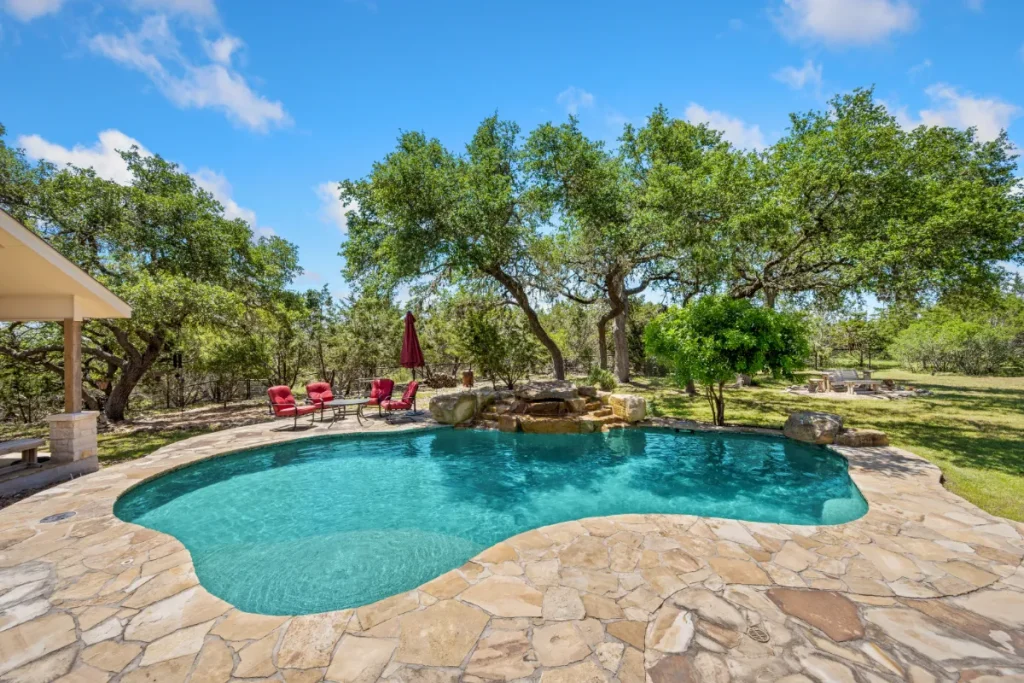
Planning the Layout
Designing a flagstone patio starts with selecting its size, shape, and intended use. Consider how you’ll use the space—whether for dining, lounging, or hosting outdoor gatherings. For a cohesive design, choose flagstones that complement the architectural style of your home and surrounding landscape. Create a scaled drawing of your patio, including built-in features like fire pits, seating walls, or outdoor kitchens. For a natural look, consider incorporating curved edges or organic shapes into the design. If you prefer a more formal appearance, opt for a rectangular or geometric layout with clean lines.
Installation Tips for a Long-Lasting Patio
Begin by excavating the patio area to a depth of 6-8 inches and adding a base layer of compacted crushed stone for stability. Spread a 2-inch layer of sand on top to create a level surface. Lay the flagstones in your chosen pattern, leaving minimal gaps for a seamless look. Tap each stone gently with a rubber mallet to ensure it’s securely set. After all the stones are in place, fill the joints with polymeric sand or mortar, brushing it into the gaps and spraying lightly with water to activate the binding agent. Sealing the finished patio will enhance its appearance and protect it from stains, moisture, and wear.
Enhancing Garden Borders and Edging with Flagstone
Using flagstone in landscaping garden borders creates well-defined planting areas while adding a touch of rustic charm. Flagstone’s natural look blends beautifully with plants and flowers, creating a cohesive and visually pleasing design.
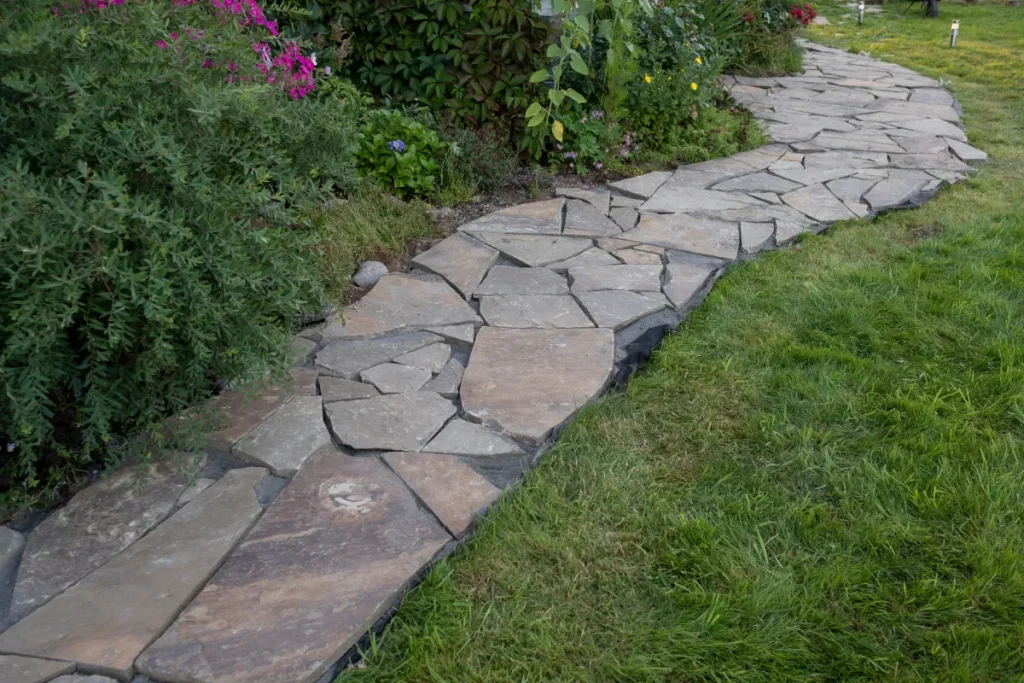
Selecting the Right Stones
The choice of flagstone for garden borders depends on the desired style and practicality of your landscape. If you want a bold, statement-making border, use larger, more prominent stones. For a subtler look, opt for smaller, evenly cut flagstones. Consider the stone’s color, thickness, and durability, especially if the edging will border high-traffic areas or require mowing along its edges. Choose flagstone that complements your garden plants, enhancing both the greenery and the stonework.
Installing Flagstone Edging
To install flagstone edging, mark the border of the garden bed using a garden hose or string for a precise outline. Dig a trench about 4-6 inches deep along the marked line. Position the flagstones upright or lay them flat, depending on the desired effect. Backfill the trench with soil or mulch to secure the stones firmly in place. For added stability, consider using landscape adhesive or mortar if the stones will be exposed to heavy foot traffic or weather elements. The result is a clean, finished edge that highlights your garden while keeping grass and weeds at bay.
Building Retaining Walls with Flagstone
Retaining walls made from flagstone serve both decorative and functional purposes. They help prevent soil erosion, create terraced landscapes, and add stunning architectural features to outdoor spaces. With the right design and installation techniques, flagstone retaining walls can be both strong and visually appealing.
Designing the Retaining Wall
Designing a flagstone retaining wall begins with determining its height, length, and purpose. If the wall is meant to hold back soil on a slope, it needs to be sturdy, well-drained, and properly reinforced. Choose flagstones with flat, wide surfaces for easier stacking and maximum stability. Consider adding curves or tiers to the wall for a more natural look that blends with the surrounding environment. A curved wall can soften the appearance of a straight garden line and create an artistic focal point. Additionally, account for wall height, as taller walls may require permits or professional engineering.
Wall Construction Techniques
Start by digging a trench where the retaining wall will be built. The trench should be approximately 6-12 inches deep, depending on the height of the wall. Fill the trench with a layer of compacted gravel to create a stable base. Place the first row of flagstones securely, ensuring each stone is level and tightly fitted to its neighbors. As you stack additional layers, stagger the joints to prevent vertical seams, enhancing both stability and aesthetics. Use smaller stones as needed to fill gaps and reinforce the structure. Consider using mortar for added strength or a dry-stacking method for a more rustic appearance. Finish by backfilling the wall with gravel or soil to improve drainage and provide additional support.
Flagstone Water Features: Ponds, Fountains, and Streams
Water features made from flagstone bring an element of tranquility and movement to your landscape. Whether you choose a pond, fountain, or stream, flagstone’s natural textures and earthy colors create a peaceful, harmonious outdoor environment.
Designing a Water Feature
When designing a flagstone water feature, start by selecting the feature type that best fits your space and budget. A pond can serve as a peaceful retreat, while a cascading waterfall creates a dynamic, eye-catching display. Bubbling fountains are perfect for smaller gardens or patios. Plan the feature’s size, shape, and location carefully. Incorporate flagstones along the edges or use them to build waterfalls and decorative inlets. Mixing different stone sizes and shapes adds a natural, organic appearance, while carefully placed aquatic plants enhance the overall aesthetic.
Installation Considerations
Begin the installation by excavating the water feature area and lining it with a waterproof liner to prevent leaks. Lay a base layer of gravel for stability before placing flagstones along the edges and in key structural areas. Arrange the stones carefully, overlapping them to create cascading effects or natural-looking stream beds. Use waterproof adhesive or mortar to secure stones where necessary. Install a water pump and filtration system to ensure proper circulation and water clarity. Add finishing touches such as aquatic plants, river rocks, and accent lighting to create a serene, finished look.
FAQs
Can flagstone be used for both modern and rustic landscapes?
Yes, flagstone is versatile and can fit various landscape designs. Its natural texture complements rustic environments, while its clean lines and uniform cuts can enhance modern aesthetics.
How long do flagstone features last?
Flagstone features can last for decades with proper installation and maintenance. Regular sealing and cleaning can extend the lifespan of flagstone patios, walls, and pathways.
Is flagstone slippery when wet?
Flagstone’s textured surface provides natural slip resistance, making it safe for outdoor areas like pool decks and patios. Sealing the stone with a slip-resistant sealer can enhance safety further.
How do I maintain a flagstone pathway or patio?
Routine maintenance involves sweeping debris, rinsing with water, and applying a stone sealer annually. Repairs can be made by resetting loose stones or refilling gaps with fresh mortar or sand.
Can I install flagstone features myself, or should I hire a professional?
While many DIY enthusiasts can handle smaller flagstone projects like garden borders or pathways, larger installations such as retaining walls, patios, or water features may require professional expertise to ensure stability and longevity.
Conclusion
Using flagstone in landscaping is an art that combines beauty, functionality, and durability. Whether you’re building a flagstone patio, pathway, garden wall, or water feature, this versatile material can elevate your outdoor space to new heights. For the best selection of premium flagstone and natural stone products, trust Lompoc Stone, a leading supplier known for its high-quality materials and expert service. Contact Lompoc Stone today to explore the perfect stone options for your next landscaping project.


